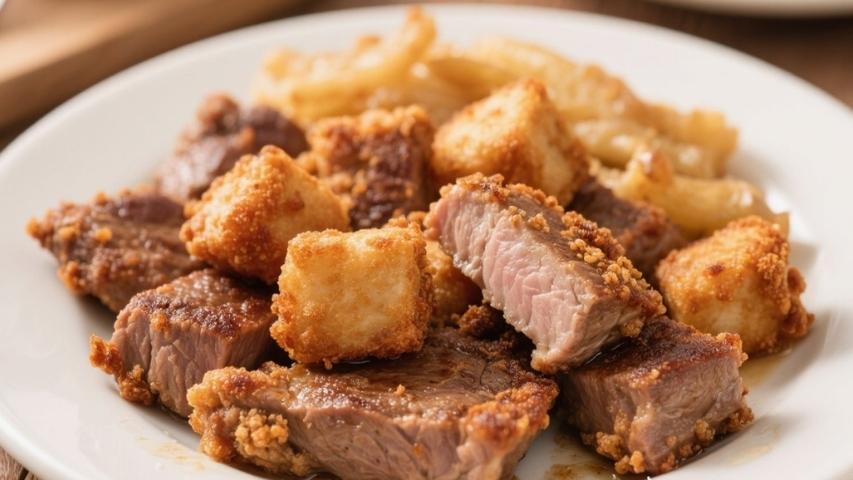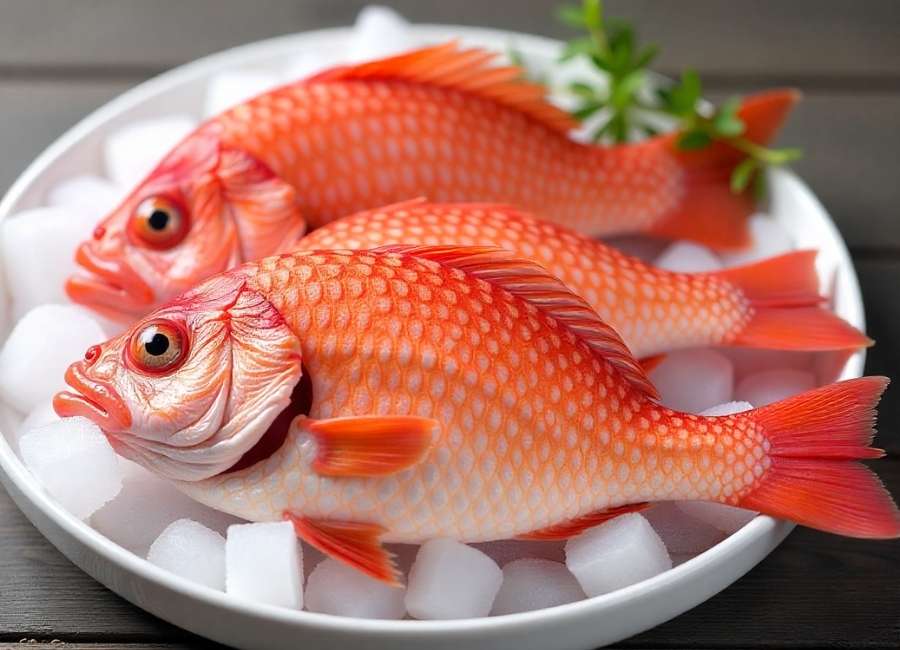Four Whole Red Snappers on Ice
Snapper has been enjoyed in kitchens worldwide for generations because of its great taste and versatility. From the Caribbean to Asia, it appears in many traditional dishes, each with its own flavors and cooking methods. Plus, snapper is usually easy to cook.
Snapper’s mild, sweet flavor and firm texture make it popular with sushi fans. Sometimes, restaurants use tilapia or rockfish instead because of price or mix-ups. These fish may look similar, but real snapper has a taste you can’t mistake. We always provide genuine snapper and are committed to quality.
This guide covers everything you need to know about snapper, from the different types to the best ways to cook it at Home.
What Kind of Fish is a Snapper?
Snapper belongs to the Lutjanidae Family and lives in the tropical waters of the Atlantic, Pacific, and Indian Oceans. (Lutjanidae – Wikipedia, n.d.) These fish have pointed heads and tails, a wide middle, sharp teeth, and bright colors. (Snapper | Saltwater, Reef, Edible, n.d.) Because they eat crustaceans and smaller fish, snappers develop a unique and tasty flavor. (Do Red and Yellow Snapper Taste the Same?, n.d.)
Is Snapper The Same As Sea Bream?

Snapper is not the same as sea bream, which includes types like dorade and porgy. While they have some similarities, sea bream has a stronger, richer flavor than snapper. (What Is Sea Bream? A Complete Guide to the Fish, 2025) Sea bream also has a rounder body and is known for its firm, flaky texture. Both fish are popular with chefs, but each offers its own unique taste and texture for different recipes.
Where Is Snapper Eaten?
Snapper plays a big part in both American and international cooking. It’s used in Caribbean dishes like escovitch fish, is seen as lucky in Chinese cuisine, and is a key ingredient in Latin American favorites like ceviche and fish tacos. In the US, red snapper is known for its sweet, nutty flavor and is often served at seafood events. (Snapper, American Red, n.d.) Snapper’s bright colors, mild taste, and ability to work with many seasonings make it a favorite for both special occasions and everyday meals.
What Does Snapper Taste Like?

Snappers have a mix of flavors and textures. Each type is a bit different, but most have a mild, sweet taste that pairs well with many ingredients. The flesh is usually firm and juicy, so it works with many cooking methods. Whether you prefer mild or bold flavors, there’s a snapper for you, making it a favorite among seafood lovers.
Snapper’s mild, sweet flavor and firm texture make it a favorite for sushi fans. Sometimes, restaurants use tilapia or rockfish instead because of cost or confusion. These fish may look like snapper, but the real thing has a unique taste.
Types of Snapper
The snapper Family is large and flavorful. There are over 100 types of snapper worldwide, each with its own traits and uses in cooking. (Snappers: Photos and Key Facts, n.d.) Here are the five most common types found in the US.
American Red Snapper
American red snapper, also known as northern red snapper, can grow up to 24 inches long. Their skin is deep red on top and fades to pink and white underneath. (Northern Red Snapper Facts & Information Guide, n.d.) Chefs around the world love this fish for its sweet, nutty flavor, which comes from its diet of crustaceans. Its firm, pink flesh makes it great for everything from sashimi to whole roasted fish.
Caribbean Red Snapper
Caribbean red snapper, also called southern red snapper, looks a lot like American red snapper but has some key differences. It has reddish-orange skin and is usually smaller, about 16-20 inches long. (Fresh Caribbean Red Snapper, Lutjanus Pupureus, n.d.) Its meat is softer and flakes into smaller pieces when cooked. Caribbean red snapper is great for pan-frying, baking, or grilling.
Yellowtail Snapper
Yellowtail snapper is smaller than red snapper, usually 12-16 inches long, with yellow stripes and a bright yellow tail. (Yellowtail Snapper | FWC, n.d.) It’s one of the most versatile types, with firm, white meat and a mild flavor. In the South, it’s often grilled with key lime in Florida or fried whole with plantains in Louisiana. You can also bake or pan-sear it with butter.
Mangrove Snapper
Mangrove snappers, also known as gray snappers or mangoes, are about the same size as yellowtail snappers, averaging 14 inches. Their color changes from gray to dark red as they age, but you can spot them by the black stripe over their eyes. Mangrove snappers are caught from the Gulf of Mexico up to Massachusetts. They have a mildly sweet taste like red snapper and a firm texture, making them popular in dishes like ceviche, grilled fish, and tacos.
Mutton Snapper
Mutton snappers, also known as mutton fish, king snapper, or virgin snapper, change color as they grow, but always have red fins and a single black spot on their backs. They are known for their complex flavor, flaky texture, and large size (20-30 inches). (Fresh Mutton Snapper (Atlantic), Lutjanus analis, n.d.) Their taste is both savory and sweet, with hints of shellfish, making them great for stews, pan-frying, or grilling with fresh herbs.
Vermillion Snapper
The vermillion snapper, also called beeliner or mingo, is easy to spot with its bright rosy color, forked tail, and crimson eyes. (Snapper, Vermilion, n.d.) It is more streamlined and smaller (14-24 inches) than red snapper but offers similar nutty flavors. Its tender flesh makes it a great choice for baked dishes and fish broths.
What Are The Health Benefits of Snapper?
Snapper is tasty and healthy. It’s low in calories and high in protein, with over 25g of protein per 100g serving. (Fish, snapper – Nutrition Facts and Calories, n.d.) With no carbs and many ways to cook it, snapper fits well into keto, Whole30, and other low-carb diets. It’s also rich in omega-3s, which are good for your heart and brain.
How Is Snapper Harvested?
Most snapper in the US is wild-caught, often using longlines, which are fishing lines with many baited hooks. (Red Snapper: Resources, n.d.) Another common method is purse seining, where a large net circles a school of fish and is pulled in to catch them.
Only a small amount of snapper comes from fish farms. (Indonesia: World’s Leading Producer of Snapper, 2017) In the US, interest in farming snapper has grown recently. (Gonzalez & Ruby, 2020) While not new, snapper farming is expanding as demand increases.
Is Snapper Sustainable?
Some snapper species face pressure from overfishing, which raises concerns about sustainability. (The number of fish on the US overfishing list reaches an all-time low. Mackerel and snapper recover, 2024) Because of this, strict rules now control snapper fishing to protect these fish for the future. (South Atlantic federal closure of red snapper 2024) Choosing responsible suppliers supports sustainable fishing and snapper conservation. We only source snapper from well-managed wild fisheries and sustainable producers. You can learn more about our sustainability efforts here.
Our Favorite Snapper Recipes
Island Style Red Snapper Recipe
Island Style Red Snapper Recipe
This recipe uses the same ingredients for the main dish, sauce, and side, creating a simple, unified meal that feels like a trip to the coast. Red snapper is tender and cooks quickly in the oven. While the fish bakes, you can prepare the salsa and salad, so you end up with a beautiful meal that stands out on your table.
Pan Seared Snapper Recipe
Pan Seared Snapper Recipe
This Mediterranean-style pan-seared snapper is one of our favorite easy and impressive seafood dishes. The sweet, fresh snapper is topped with sautéed tomato, olives, and basil, and served with golden potatoes.
Roasted Whole Red Snapper Recipe
Roasted Whole Red Snapper Recipe
Roasting whole red snapper takes little time or effort and delivers great flavor. Use this recipe for an impressive meal.



